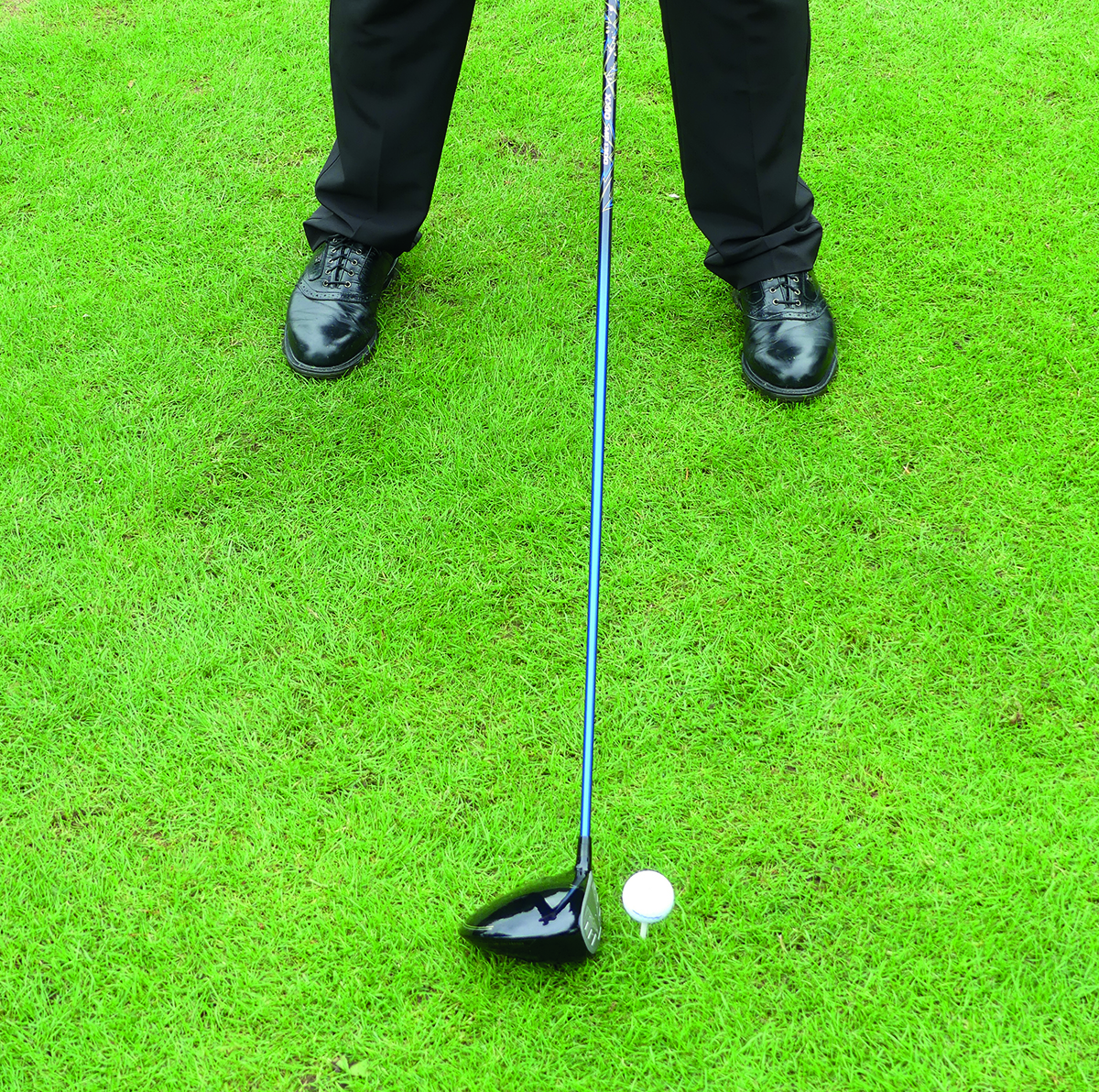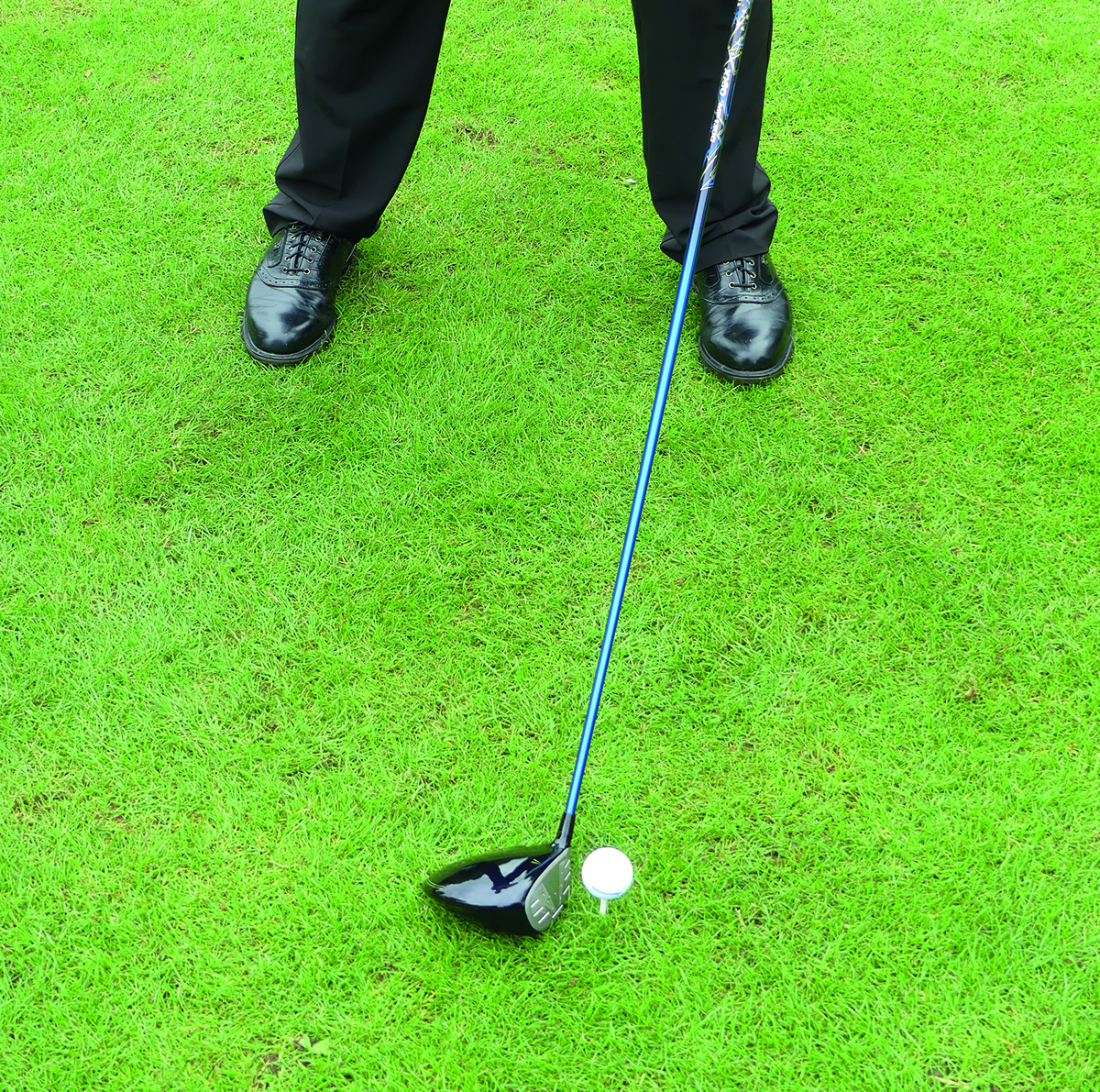The Driver with Julian Mellor
Book Extract
1. Tee Height & Type Of Ball
The optimum tee height is when you can see half of the golf ball above the top of your driver.
I like the idea of using set-height tees as this takes out the guesswork. The height of your driver head will determine the length of tee you need.
Ideally get a friend to hold the driver next to the ball and tee so you can check that you can see half the ball.
If the tee is too high you will go underneath the ball and if it’s too low you will hit low on the clubface and probably not get the ball in the air.
If you have a slow clubhead speed choose a softer ball, which will compress then spring forward. A slowly moving clubhead won’t compress a hard ball – leave that to the pros!

With the correct tee height, half the ball is above the driver’s face
2. Ball Position
The ideal ball position is opposite your left heel. The easiest way to check this is to put an alignment rod next to the ball pointing towards your body.
The driver moves in a circle. The bottom of The Circle is in the centre of your stance, but you want to hit the ball as The Circle is starting to rise. That’s why you have the ball forward in your stance.

Check the position of the ball (opposite your front heel) with an alignment rod
3. Width Of Stance
The normal stance is a natural stride, but increase that by a shoe width for driving because you swing the driver fast and need stability for that.

Your normal stance is a natural stride, but increase that by a shoe width for driving
4. Weight Distribution
Normally you will have your weight 50-50 on each foot but with the driver it's better to make it 60-40 favouring your back foot. When you get it right it feels like you're pointing slightly upwards. The worst thing you can do with the driver is have too much weight on your front foot at address.
5. Posture
Take your stance as described in pages 16-19. Because the ball is forward in your stance the shaft of the driver will have a slight lean backwards. (If it’s forwards you will be taking loft off the clubface and may be opening it.) Check that your weight is evenly distributed between your toes and heels to give a very stable base.


LEFT: With the ball forward in your stance, the shaft of the driver should lean slightly backwards
RIGHT: Incorrect: if the shaft leans forwards you will be taking loft off the clubface and may be opening it
6. Alignment
You have already learnt to align your club, and parallel to that your feet, knees, hips and shoulders. However, with the driver I don’t mind your feet pointing slightly to the right as this allows a bit more hip turn and lets you hit the inside of the ball more easily. The worst thing is to point your feet left, as you are likely to hit the outside of the ball and either pull or slice your tee shot.
7. Shoulders
I like to see the left shoulder higher than the right. This is because your right hand is lower than your left hand on the grip and the ball is forward in your stance. It feels as if you are pointing slightly upwards.

The left shoulder should be slightly higher to tie in with the height of your hands
8. Tension
Now that you are set up correctly I want you to think about one last thing and that is tension. So often I see golfers take a sharp intake of breath just before they start the backswing. This causes the body to tighten and the muscles shorten and will make you lose distance. Instead take a deep breath, hold it for two seconds and then breathe out. Make your golf swing without breathing in again.
9. The Backswing
Turn your body to start the backswing. This creates a natural width to the swing and helps with timing and rhythm. Once the shaft is at hip height begin to use your wrists in a natural throwing action like casting a fishing line. This moves the back of the clubface onto The Circle. Keep your front arm relaxed as you turn your shoulders to 90 degrees and your hips to 45 degrees. Your left thumb will be underneath the club, supporting it.
10. The Downswing
The clue is in the title: your arms move down (and your weight shifts onto your lead foot) putting the club into a position where you can strike the inside of the ball. At the same time your body turns left bringing your shoulders back to the address position and your hips start to open.
11. Through-Swing
Remember: keeping your head down is really bad.
Just before impact allow your eyes to begin following the flight of the ball. This allows your head to turn which encourages your body to turn and your weight to transfer. Your arms feel long until hip height and from this point your arms will start to fold naturally, allowing the club to flow over your shoulder. Your weight will have fully transferred onto your front foot, and your head, shoulders, hips and back knee will be pointing towards the target. You should be able to maintain a balanced finish and hold it until the golf ball lands. Simple really!
